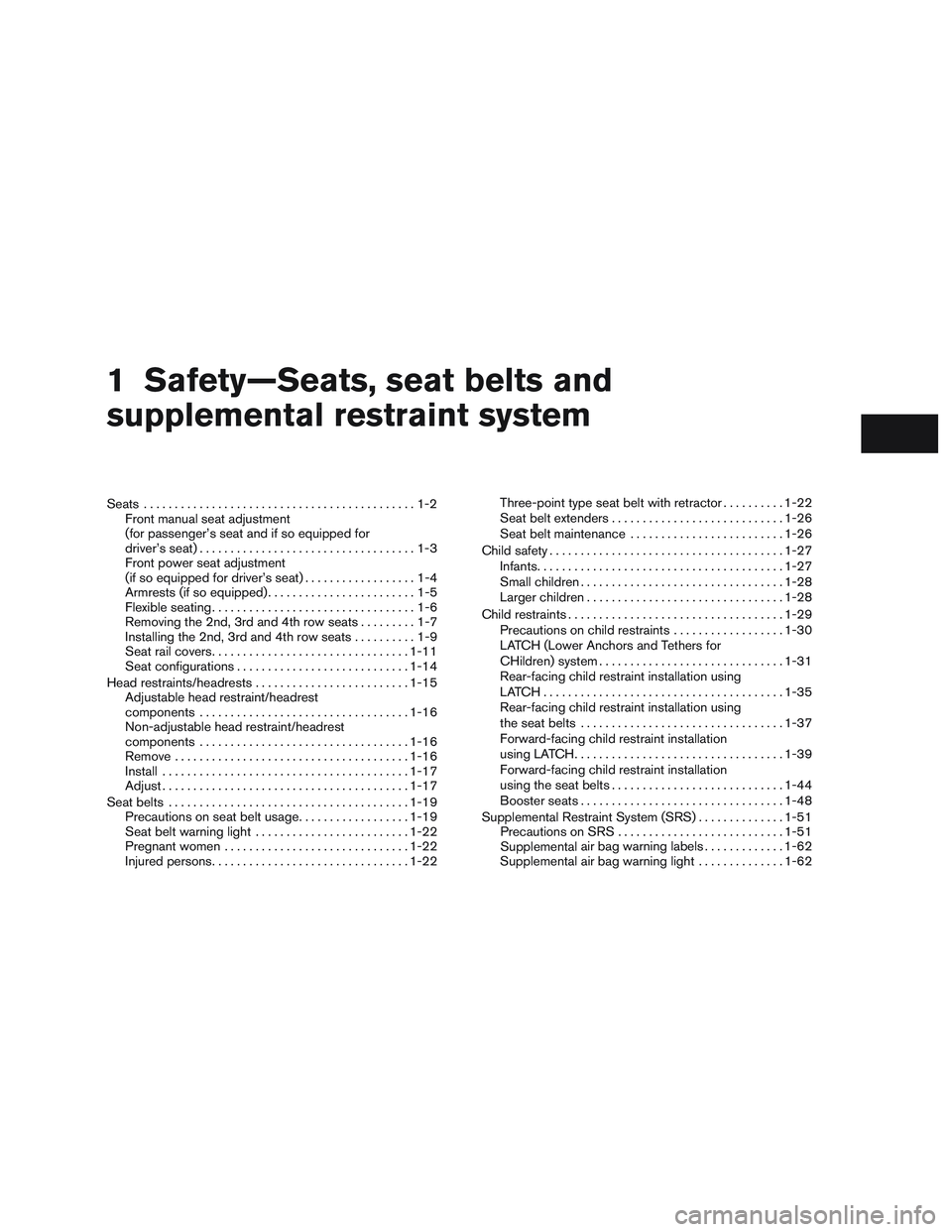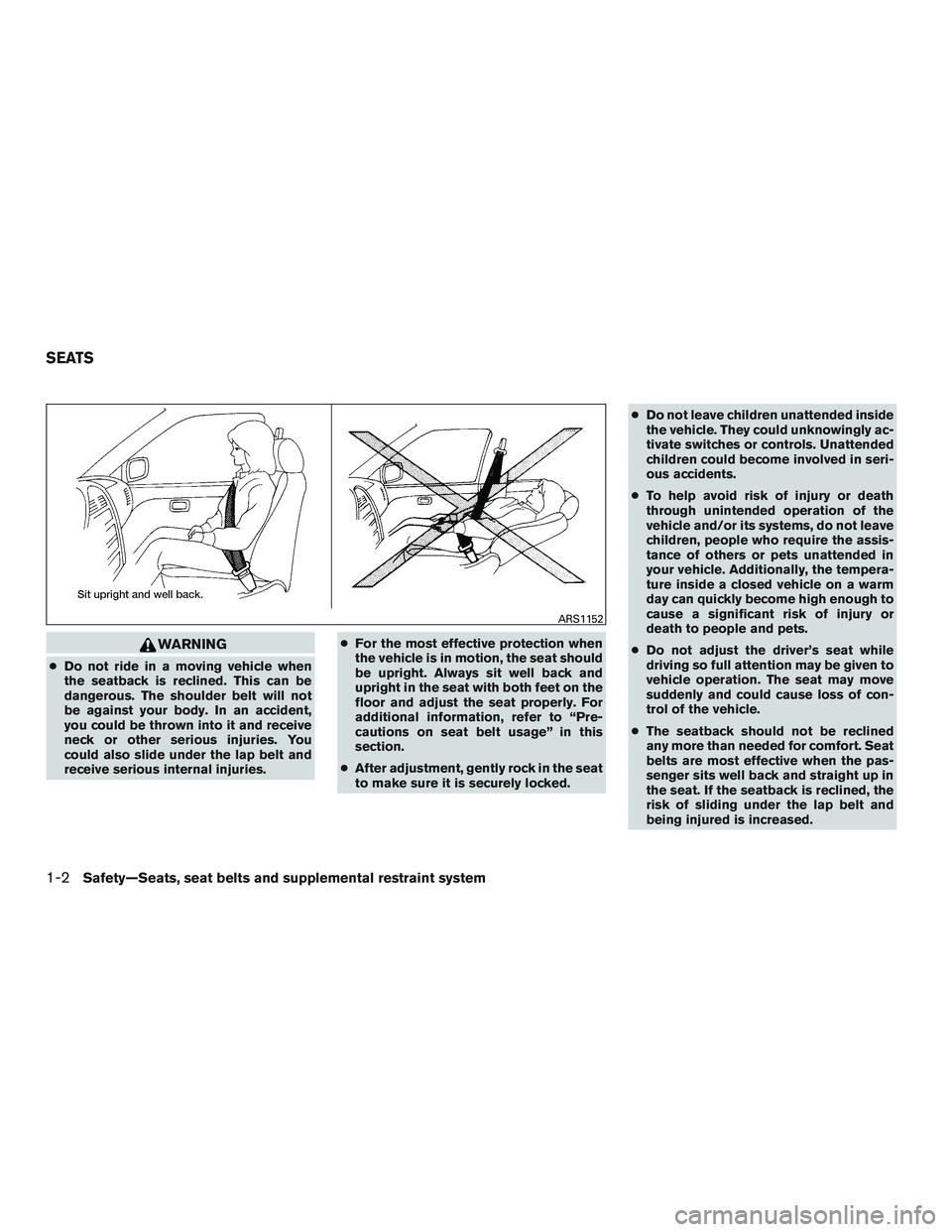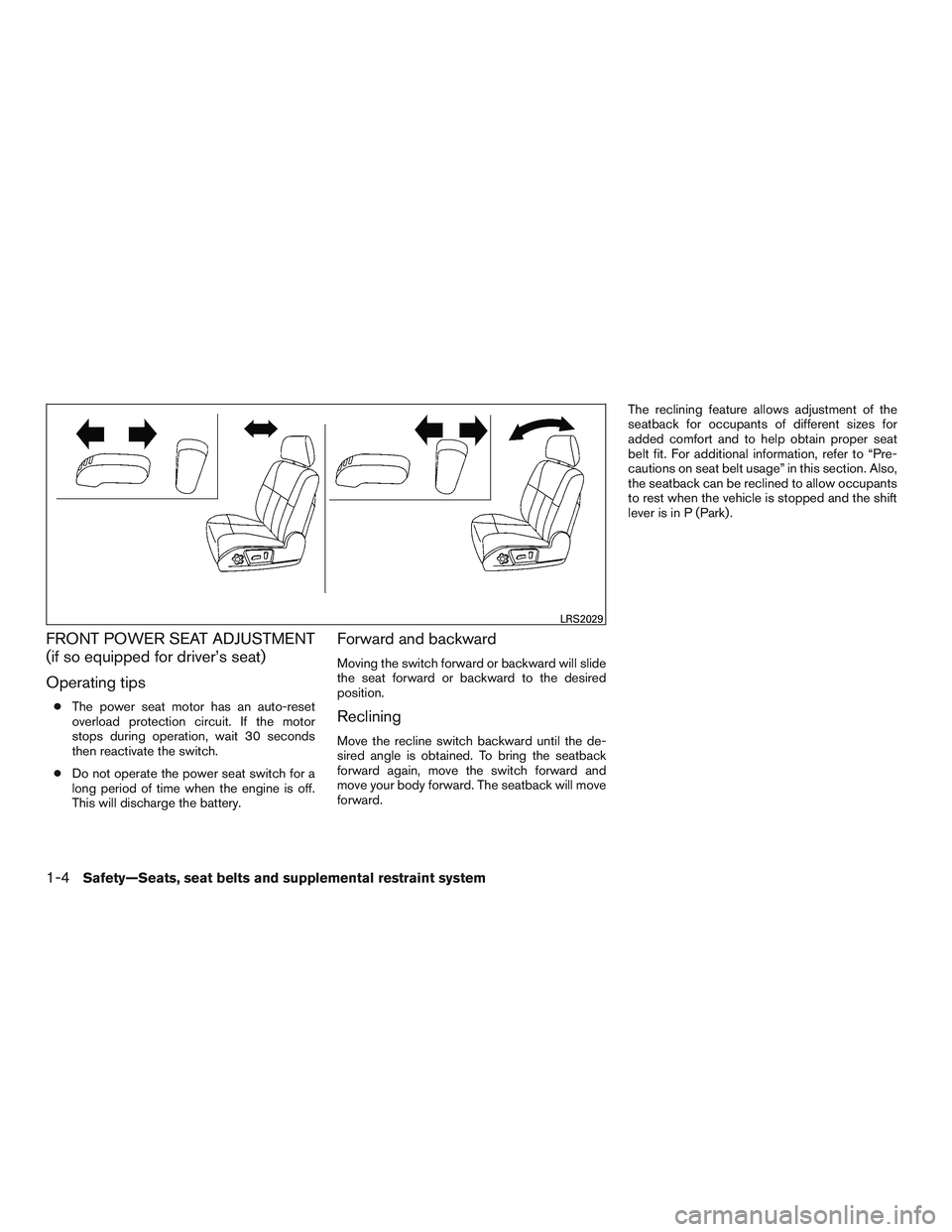Page 8 of 380
Table of
ContentsIllustrated table of contents
Safety—Seats, seat belts and supplemental restraint system
Instruments and controls
Pre-driving checks and adjustments
Monitor, climate, audio, phone and voice recognition systems
Starting and driving
In case of emergency
Appearance and care
Maintenance and do-it-yourself
Technical and consumer information
Index
0
1
2
3
4
5
6
7
8
9
10
Page 11 of 380
1. Head restraints/headrests (2nd, 3rdand 4th rows) (P. 1-15)
2. LATCH (Lower Anchors and Tethers for
CHildren) system (second row shown;
3rd and 4th rows similar) (P. 1-29)
3. Head restraints/headrests (front row)
(P. 1-15)
4. Front seat belts (P. 1-19, 1-51)
5. Roof-mounted curtain side-impact and
rollover supplemental air bag (P. 1-51)
6. Supplemental front-impact air bags
(P. 1-51)
7. Front seats (P. 1-2)
8. Front seat-mounted side-impact
supplemental air bag (P. 1-51)
9. Top tether strap anchor points (2nd,
3rd, and 4th rows — found on bottom
of seatback) (2nd row shown; other
rows similar) (P. 1-29)
10. Rear seat configurations (P. 1-2)
Refer to the page number indicated in pa-
rentheses for operating details.
LII2319
AIR BAGS, SEAT BELTS AND CHILD
RESTRAINTS
0-2Illustrated table of contents
Page 14 of 380
1. Map lights (P. 2-48)
2. Sun visors (P. 3-16)
3. Inside mirror (P. 3-17)
4. Steering wheel (P. 3-15)
5. Glove box (P. 2-38)
6. Console box (if so equipped) (P. 2-38)
7. Front seats (P. 1-2)
8. Cup holders (mounted to lower seatframe) (2nd row shown; 3rd and 4th
rows similar) (P. 2-38)
9. Rear seat configurations (P. 1-2)
Refer to the page number indicated in pa-
rentheses for operating details.
LII2024
PASSENGER COMPARTMENT
Illustrated table of contents0-5
Page 22 of 380

1 Safety—Seats, seat belts and
supplemental restraint system
Seats............................................1-2
Front manual seat adjustment
(for passenger’s seat and if so equipped for
driver’s seat) ...................................1-3
Front power seat adjustment
(if so equipped for driver’s seat) ..................1-4
Armrests (if so equipped) ........................1-5
Flexible seating .................................1-6
Removing the 2nd, 3rd and 4th row seats .........1-7
Installing the 2nd, 3rd and 4th row seats ..........1-9
Seat rail covers ................................ 1-11
Seat configurations ............................ 1-14
Head restraints/headrests ......................... 1-15
Adjustable head restraint/headrest
components .................................. 1-16
Non-adjustable head restraint/headrest
components .................................. 1-16
Remove ...................................... 1-16
Install ........................................ 1-17
Adjust ........................................ 1-17
Seat belts ....................................... 1-19
Precautions on seat belt usage ..................1-19
Seat belt warning light ......................... 1-22
Pregnant women .............................. 1-22
Injured persons ................................ 1-22Three-point type seat belt with retractor
..........1-22
Seat belt extenders ............................ 1-26
Seat belt maintenance ......................... 1-26
Child safety ...................................... 1-27
Infants ........................................ 1-27
Small children ................................. 1-28
Larger children ................................ 1-28
Child restraints ................................... 1-29
Precautions on child restraints ..................1-30
LATCH (Lower Anchors and Tethers for
CHildren) system .............................. 1-31
Rear-facing child restraint installation using
LATCH....................................... 1-35
Rear-facing child restraint installation using
the seat belts ................................. 1-37
Forward-facing child restraint installation
using LATCH .................................. 1-39
Forward-facing child restraint installation
using the seat belts ............................ 1-44
Booster seats ................................. 1-48
Supplemental Restraint System (SRS) ..............1-51
Precautions on SRS ........................... 1-51
Supplemental
air bag warning labels .............1-62
Supplemental air bag warning light ..............1-62
Page 23 of 380

WARNING
●Do not ride in a moving vehicle when
the seatback is reclined. This can be
dangerous. The shoulder belt will not
be against your body. In an accident,
you could be thrown into it and receive
neck or other serious injuries. You
could also slide under the lap belt and
receive serious internal injuries. ●
For the most effective protection when
the vehicle is in motion, the seat should
be upright. Always sit well back and
upright in the seat with both feet on the
floor and adjust the seat properly. For
additional information, refer to “Pre-
cautions on seat belt usage” in this
section.
● After adjustment, gently rock in the seat
to make sure it is securely locked. ●
Do not leave children unattended inside
the vehicle. They could unknowingly ac-
tivate switches or controls. Unattended
children could become involved in seri-
ous accidents.
● To help avoid risk of injury or death
through unintended operation of the
vehicle and/or its systems, do not leave
children, people who require the assis-
tance of others or pets unattended in
your vehicle. Additionally, the tempera-
ture inside a closed vehicle on a warm
day can quickly become high enough to
cause a significant risk of injury or
death to people and pets.
● Do not adjust the driver’s seat while
driving so full attention may be given to
vehicle operation. The seat may move
suddenly and could cause loss of con-
trol of the vehicle.
● The seatback should not be reclined
any more than needed for comfort. Seat
belts are most effective when the pas-
senger sits well back and straight up in
the seat. If the seatback is reclined, the
risk of sliding under the lap belt and
being injured is increased.
ARS1152
SEATS
1-2Safety—Seats, seat belts and supplemental restraint system
Page 24 of 380

CAUTION
When adjusting the seat positions, be
sure not to contact any moving parts to
avoid possible injuries and/or damage.
FRONT MANUAL SEAT
ADJUSTMENT (for passenger’s seat
and if so equipped for driver’s seat)
Your vehicle seats can be adjusted manually. For
additional information about adjusting the seats,
refer to the steps outlined in this section.
Forward and backward
Pull the lever up and hold it while you slide the
seat forward or backward to the desired position.
Release the lever to lock the seat in position.
Reclining
To recline the seatback, pull the lever up and lean
back. To bring the seatback forward, pull the lever
up and lean your body forward. Release the lever
to lock the seatback in position.
The reclining feature allows adjustment of the
seatback for occupants of different sizes for
added comfort and to help obtain proper seat
belt fit. For additional information, refer to “Pre-
cautions on seat belt usage” in this section. Also,
the seatback can be reclined to allow occupants
to rest when the vehicle is stopped and the shift
lever is in the P (Park) position.
LRS2038LRS2039
Safety—Seats, seat belts and supplemental restraint system1-3
Page 25 of 380

FRONT POWER SEAT ADJUSTMENT
(if so equipped for driver’s seat)
Operating tips
●The power seat motor has an auto-reset
overload protection circuit. If the motor
stops during operation, wait 30 seconds
then reactivate the switch.
● Do not operate the power seat switch for a
long period of time when the engine is off.
This will discharge the battery.
Forward and backward
Moving the switch forward or backward will slide
the seat forward or backward to the desired
position.
Reclining
Move the recline switch backward until the de-
sired angle is obtained. To bring the seatback
forward again, move the switch forward and
move your body forward. The seatback will move
forward. The reclining feature allows adjustment of the
seatback for occupants of different sizes for
added comfort and to help obtain proper seat
belt fit. For additional information, refer to “Pre-
cautions on seat belt usage” in this section. Also,
the seatback can be reclined to allow occupants
to rest when the vehicle is stopped and the shift
lever is in P (Park) .
LRS2029
1-4Safety—Seats, seat belts and supplemental restraint system
Page 26 of 380
Seat lifter
Push the front or rear end of the switch up or
down to adjust the angle and height of the seat
cushion.
Lumbar support
The lumbar support feature provides adjustable
lower back support to the driver. Turn the knob
forward or backward to adjust the seat lumbar
area.
ARMRESTS (if so equipped)
To use the armrests, pull them down to the rest-
ing position.
�AStowed position
�BResting position
LRS2030LRS2040LRS2041
Safety—Seats, seat belts and supplemental restraint system1-5